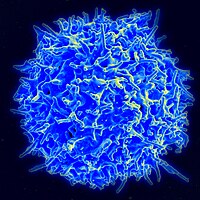
Photo from wikipedia
The γδ T cells play an important role in both mice and humans as a source of the cytokine IL‐17, which is key for immune resistance to certain pathogens. In… Click to show full abstract
The γδ T cells play an important role in both mice and humans as a source of the cytokine IL‐17, which is key for immune resistance to certain pathogens. In mice, most of these IL‐17 producers, termed γδT‐17 cells, actually comprise two distinct types: those expressing an invariant Vγ6Vδ1+ TCR and those expressing a Vγ4+ TCR. Murine γδT‐17 cells acquire an inherent bias to produce IL‐17 and other “type 17” cytokines during thymic development. The similarities and differences between the two mouse γδT‐17 types are reviewed here, and the potential implications of their differences are discussed. There is some evidence that two distinct TCR‐defined IL‐17‐producing γδ T cell subsets also exist in humans, but unlike the mouse γδT‐17 cells, these cells are probably not imprinted with an IL‐17 bias during thymic development, but rather acquire an IL‐17 bias in the periphery.
Journal Title: Immunological Reviews
Year Published: 2020
Link to full text (if available)
Share on Social Media: Sign Up to like & get
recommendations!